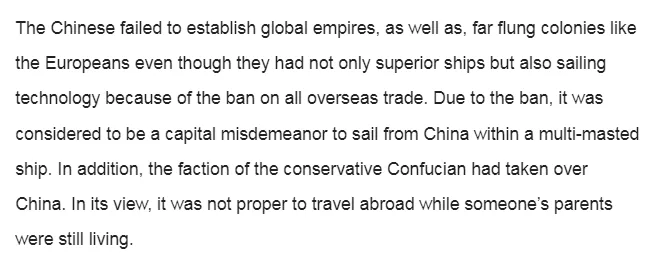“Global Encounters: Achievements and Exploitation” Please respond to the following:
Chapter 18 finishes our course on the issue of global encounters in the 1400s-1500s AD/CE, an early step to what is now modern globalization. Note that this was not just the western nations going to other parts of the globe. China had a grand yet brief period of global reach (as it now has today), a period when China ruled the seas. For about three (3) decades in the early 1400s AD, China was sending a massive fleet on regular expeditions to lands near and far, seeking knowledge and tribute. Read pp. 606-608 in our class text. By the mid-1430s AD, China did an about-face in policy and became fairly isolationist from then until the mid-1800s. This is one of the most remarkable subjects of world history. Some theories say this fleet made forays to New World lands of the western hemisphere, but most currently doubt that. But the size of the ships, the advanced sailing methods, the size of the crews, and the knowledge and items collected have made this a thrilling chapter in world history. See http://www.pbs.org/wgbh/nova/ancient/ancient-chinese-explorers.html and http://www.alrahalah.com/2010/09/zheng-he/. Some of the visuals at these Websites show how much larger these ships were than those of Columbus. See the large replica at http://www.alrahalah.com/wp-content/uploads/2010/09/TreasureShip.jpg. In India (pp. 604-5), we see the rise of a Muslim dynasty known as the Moguls, and that splendid achievement known as the Taj Mahal. Explore this structure at http://asi.nic.in/asi_monu_whs_agratajmahal.asp, and watch the video at http://www.youtube.com/watch?v=ppAQDPb8DYM.This period had its unpleasant side also, as technologically-advanced cultures exploit less developed ones. Nowhere is this more evident than in the transatlantic slave trade (p. 597), which is presented at the Website on the Middle Passage at http://www.pbs.org/wgbh/aia/part1/1p277.html. The Portuguese and Spanish take over large sections of the Americas in remarkably rapid fashion (pp. 588-595). By all accounts, the Chinese had superior ships and sailing technology than the Europeans in the 1400s. But, the Europeans ended up establishing global empires and far-flung colonies; the Chinese did not. Identify key factors that might explain this difference. Discuss the motives and inspirations for the construction of the Taj Mahal. Discuss the aspects of the Taj Mahal that you think contribute most to its beauty. Based on this chapter and the Website on the subject of the Middle Passage, discuss a statistic and an aspect of the transatlantic slave trade that you find the most revealing about the human cost and this experience. Identify the key factors that made it possible for the Spanish and Portuguese to so quickly prevail in the Americas.
Answer Preview-Global Encounters: Achievements and Exploitation

